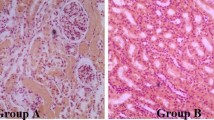Summary
The effect of the ingestion of phenolphthalein in therapeutic doses on the liver was investigated.
-
(a)
The study of the history of 300 cases of jaundice failed to show an etiologic role of phenolphthalein.
-
(b)
The administration of phenolphthalein to 120 jaundiced patients did not change the clinical picture and did not interfere with recovery.
-
(c)
Phenolphthalein administered to 425 non-jaundiced patients did not produce jaundice.
-
(d)
Periodic liver function tests on 12 patients with chronic constipation, taking 0.30 Gm. of white or 0.12 Gm. of yellow phenolphthalein, daily, for months, did not reveal signs of liver damage.
Our study indicates that phenolphthalein, in larger than usual therapeutic doses, is not harmful to the liver.
These results are supported by the fact that a critical review of the literature has failed to disclose cases of liver damage following the ingestion of phenolphthalein, notwithstanding its extensive use as a laxative.
Similar content being viewed by others
References
Fantus, B., Steigmann, F. and Dyniewicz, J. M. : “Phenolphthalein in Blood and Urine as Liver and Kidney Function Test.”J. Pharmacology and Exp. Therapeutics, Aug., 1940.
McGuigan, H. A.: Applied Pharmacology. St. Louis, the C. V. Mosby Co., 1940. b. Soliman, T. H. and Hanzlik, P. J.: Fundamentals of Experimental Pharmacology. 2nd ed., San Francisco, J. W. Stacey and Co., 1939. c. Meyer, H. H. and Gottlieb, R. : Pharmacology, Clinical and Experimental. Philadelphia and London, J. B. Lippineott Co., 1914. d. Cushny, A. R. : A Textbook of Pharmacology and Therapeutics. 11th ed., Philadelphia, Lea and Febiger, 1986.
Fantus, B. and Dyniewicz, J. M.: “A Thousand Doses of Phenolphthalein: Urinalyses.”J. A. M. A., 108:439–443, Feb., 1937.
Hydrick, J. L.: “Albuminuria Following Ingestion of Phenol- phthalein.”Proc. Am. Soc. Biol. Chem. J. Biol. Chem., 17:36, 1914.
Mendelsohn, M. : “Über Abführen und Abführmittel.”Deutsche Artzte-Zeitung, Jan. 15, 1905.
Schmilinsky, K.: Deutsche Medizinische Wochenschrift. No. 39, p. 1311, 1922.
Blumenthal, F.: Medizinische Klinik. No. 33, p. 841. 1905.
Cleeves, M.: “Poisoning by ‘Exlax’ Tablets.”J. A. M. A., 99:664, Aug. 20, 1932.
Gillette, H. F.: “Accidental Overdose of Phenolphthalein.”J. A. M. A., 51:1782, Nov. 21, 1908.
Orland, F.: “Ein Fall von Unbeabsichtiger hoher Phenolphthaleindosis bei einem Kinde.”Med. Klin., 9:257, 1913.
Sachs, W.: “Accidental Overdose of Phenolphthalein in Child Without Ill Effects.”J. A. M. A., 104:45, Jan. 5, 1935.
Author information
Authors and Affiliations
Rights and permissions
About this article
Cite this article
Fantus, B., Steigmann, F. & Dyniewicz, J.M. The influence of phenolphthalein on the liver. Jour. D. D. 8, 176–179 (1941). https://doi.org/10.1007/BF02998286
Received:
Issue Date:
DOI: https://doi.org/10.1007/BF02998286




